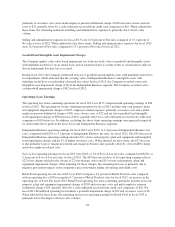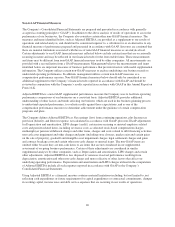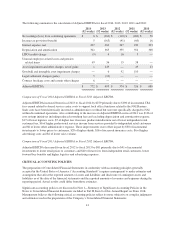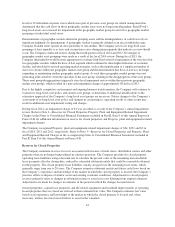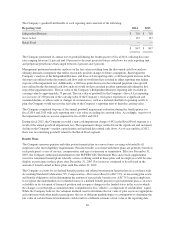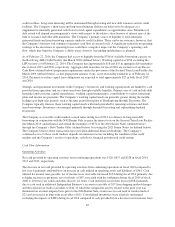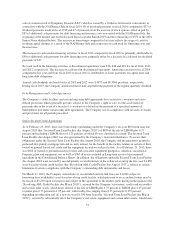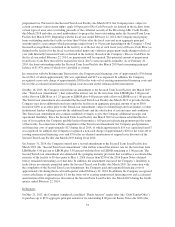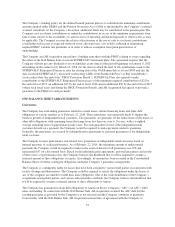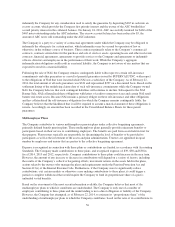Albertsons 2014 Annual Report Download - page 49
Download and view the complete annual report
Please find page 49 of the 2014 Albertsons annual report below. You can navigate through the pages in the report by either clicking on the pages listed below, or by using the keyword search tool below to find specific information within the annual report.The determination of the Company’s obligation and related expense for Company-sponsored pension and other
postretirement benefits is dependent, in part, on management’s selection of certain actuarial assumptions used in
calculating these amounts. These assumptions include, among other things, the discount rate, the expected long-
term rate of return on plan assets and the rates of increase in compensation and healthcare costs. Refer to Note
11-Benefit Plans in the Notes to Consolidated Financial Statements included in Part II, Item 8 of this Annual
Report on Form 10-K for additional discussion of actuarial assumptions used in determining pension and
postretirement health care liabilities and expenses.
The Company reviews and selects the discount rate to be used in connection with its pension and other
postretirement obligations annually. The discount rate reflects the current rate at which the associated liabilities
could be effectively settled at the end of the year. The Company sets its rate to reflect the yield of a portfolio of
high quality, fixed-income debt instruments that would produce cash flows sufficient in timing and amount to
settle projected future benefits.
The Company’s expected long-term rate of return on plan assets assumption is determined based on the
portfolio’s actual and target composition, current market conditions, forward-looking return and risk assumptions
by asset class, and historical long-term investment performance. The assumed long-term rate of return on pension
assets for fiscal 2014 and fiscal 2013 was 7.00 percent and 7.25 percent, respectively. The 10 year rolling
average annualized return for investments made in a manner consistent with our target allocations have generated
average returns of approximately 8.3 percent based on returns from 1990 to 2013. In accordance with Accounting
Standards, actual results that differ from the Company’s assumptions are accumulated and amortized over future
periods and, therefore, affect expense and obligations in future periods.
At February 25, 2012, the Company converted to the 2012 Static Mortality Table for Annuitants and Non-
Annuitants for calculating the pension and postretirement obligations and the annual expense. The impact of this
change increased the February 25, 2012 projected benefit obligation by $10 and the accumulated postretirement
benefit obligation by $1. This change increased the fiscal 2013 defined benefit pension plans expense by $2. The
Static Mortality Table for Annuitants and Non-Annuitants is published annually and reflects a static projection of
mortality improvements which are projected forward each year. The Company used the 2014 Static Mortality
Table for Annuitants and Non-Annuitants to calculate the pension and postretirement obligations.
During fiscal 2014, the Company contributed $118 to its defined benefit pension plans and approximately $6 to
its postretirement benefit plans in fiscal 2014, and expects to contribute approximately $130 to $140 to its
defined benefit pension plans and postretirement benefit plans in fiscal 2015.
For fiscal 2015, each 25 basis point reduction in the discount rate would increase pension expense by
approximately $11 and each 25 basis point reduction in expected return on plan assets would increase pension
expense by approximately $5. Similarly, for postretirement benefits, a 100 basis point increase in the healthcare
cost trend rate would increase the accumulated postretirement benefit obligation as of the end of fiscal 2014 by
approximately $6, and would increase service and interest cost by less than $1. Conversely, a 100 basis point
decrease in the healthcare cost trend rate would decrease the accumulated postretirement benefit obligation as of
the end of fiscal 2014 by approximately $5, and would decrease service and interest cost by less than $1.
Although the Company believes that its assumptions are appropriate, the actuarial assumptions may differ from
actual results due to changing market and economic conditions, higher or lower withdrawal rates and longer or
shorter life spans of participants.
Income Taxes
The Company’s current and deferred tax provision is based on estimates and assumptions that could materially
differ from the actual results reflected in its income tax returns filed during the subsequent year and could
significantly affect the effective tax rate and cash flows in future years.
The Company recognizes deferred tax assets and liabilities for the expected tax consequences of temporary
differences between the tax bases of assets and liabilities and their reported amounts using enacted tax rates in
effect for the year in which it expects the differences to reverse.
47



